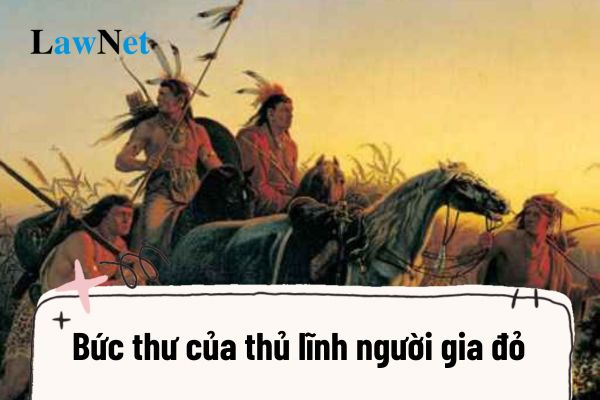What are the guidelines for preparating the lesson "Letter from the Red Indian Chief/Bức thư của thủ lĩnh da đỏ"? What are the assessment forms after completion of the 8th-grade Literature curriculum?
What are the guidelines for preparating the lesson "Letter from the Red Indian Chief/Bức thư của thủ lĩnh da đỏ" of Seattle in the 8th-grade Literature curriculum - Creative Horizon?
According to the General education program in Literature issued together with Circular 32/2018/TT-BGDDT download here, the work "Letter from the Red Indian Chief/Bức thư của thủ lĩnh da đỏ" is one of the suggested text corpora in the Literature curriculum.
Students may refer to the guidelines for preparating the lesson "Letter from the Red Indian Chief/Bức thư của thủ lĩnh da đỏ" of Seattle in the 8th-grade Literature curriculum - Creative Horizon below:
|
Preparating the lesson "Letter from the Red Indian Chief/Bức thư của thủ lĩnh da đỏ" of Seattle in the 8th-grade Literature curriculum - Creative Horizon 1. Main Content |
Note: Information is for reference only./.

What are the guidelines for preparating the lesson "Letter from the Red Indian Chief/Bức thư của thủ lĩnh da đỏ" of Seattle in the 8th-grade Literature curriculum - Creative Horizon? (Image via Internet)
What are the assessment forms after completion of the 8th-grade Literature curriculum in Vietnam?
Based on Section 7 of the General education program in Literature issued together with Circular 32/2018/TT-BGDDT, two forms of assessment for 8th-grade Literature are regulated as follows:
- Regular assessment
+ Teachers assess students, students assess each other, and students self-assess. For regular assessment, teachers can rely on daily observations and notes about students, responses to questions or presentations, taking tests, writing analyses and literary feedback, completing projects, gathering materials, doing research exercises, etc.
- Periodic assessment
+ Conducted near the end or after a learning period (end of term, end of school year) organized by educational institutions to manage teaching activities, ensure education quality, and develop curriculum and learning materials.
+ Periodic assessment is often conducted through written tests or examinations. Tests or exams may require essay forms (one or more questions);
+ It may combine objective multiple-choice forms (objective multiple-choice questions) and essay forms (open-ended questions) to assess reading comprehension and demand written responses on any studied topic.
+ Oral examinations (to assess speaking and listening) can be used if necessary and conditions permit. When evaluating the academic outcomes at the end of the school year, end of each educational level, it's important to innovate the assessment methods (like the structure of the exam, question presentation, levels of difficulty,...);
+ Utilize and analyze materials to ensure the assessment reflects the students' capabilities, preventing students from merely memorizing or copying available documents;
+ Avoid reusing studied documents to accurately assess reading comprehension and analysis, literary appreciation.
Is fostering healthy emotions, humanitarian feelings, and altruistic lifestyles for students one of the characteristics of 8th-grade Literature in Vietnam?
Under Section 1 of the General education program in Literature issued together with Circular 32/2018/TT-BGDDT download, the 8th-grade Literature has the following characteristics:
- 8th-grade Literature is a subject with a tool-oriented and aesthetic-humanitarian nature, providing students with the means of communication, forming the foundation for learning all other subjects and educational activities within the school;
- It is an important tool for educating students about cultural, literary, and national language values; fostering healthy emotions, humanitarian feelings, and altruistic lifestyles,...
- Through language texts and vivid artistic imagery within literary works, via reading, writing, speaking, and listening activities, Literature plays a substantial role in helping students form and develop noble qualities as well as core life skills;
- The content of 8th-grade Literature is comprehensive, incorporating cultural, ethical, and philosophical knowledge intricately linked with life, helping students develop a closer bond with everyday life;
- The core content of 8th-grade Literature includes foundational, essential knowledge and skills in Vietnamese language and literature distributed into two phases: foundational education phase and career-oriented education phase:
+ Foundational Education Phase: The curriculum is designed around main strands corresponding to reading, writing, speaking, and listening skills. Vietnamese and literary knowledge is integrated throughout the teaching of reading, writing, speaking, and listening. The goal of this phase is to help students use Vietnamese fluently for effective communication in life;
+ Career-Oriented Education Phase: The program consolidates and enhances outcomes from the foundational education phase, improving students' capabilities in language and literature, especially in literary text reception; and enhancing argumentative text and informative text creation skills with more complex content and writing techniques.
Thus, fostering healthy emotions, humanitarian feelings, and altruistic lifestyles for students is one of the characteristics of 8th-grade Literature in Vietnam.

